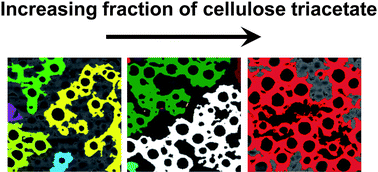Phase-specific pore growth in ultrathin bicomponent films from cellulose-based polysaccharides†
Abstract
The preparation of ultrathin (<100 nm) bicomponent films from hydrophobic

* Corresponding authors
a
Department of Forest Products Technology, School of Chemical Technology, Aalto University, P. O. Box 16300, Aalto, Finland
E-mail:
eero.kontturi@aalto.fi, laura.taajamaa@aalto.fi
b
Department of Forest Biomaterials, North Carolina State University, Box 8005, Raleigh, North Carolina, USA
E-mail:
orlando_rojas@ncsu.edu
The preparation of ultrathin (<100 nm) bicomponent films from hydrophobic

 Please wait while we load your content...
Something went wrong. Try again?
Please wait while we load your content...
Something went wrong. Try again?
L. Taajamaa, O. J. Rojas, J. Laine and E. Kontturi, Soft Matter, 2011, 7, 10386 DOI: 10.1039/C1SM06020A
To request permission to reproduce material from this article, please go to the Copyright Clearance Center request page.
If you are an author contributing to an RSC publication, you do not need to request permission provided correct acknowledgement is given.
If you are the author of this article, you do not need to request permission to reproduce figures and diagrams provided correct acknowledgement is given. If you want to reproduce the whole article in a third-party publication (excluding your thesis/dissertation for which permission is not required) please go to the Copyright Clearance Center request page.
Read more about how to correctly acknowledge RSC content.
 Fetching data from CrossRef.
Fetching data from CrossRef.
This may take some time to load.
Loading related content
